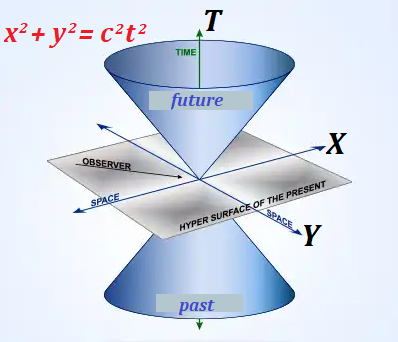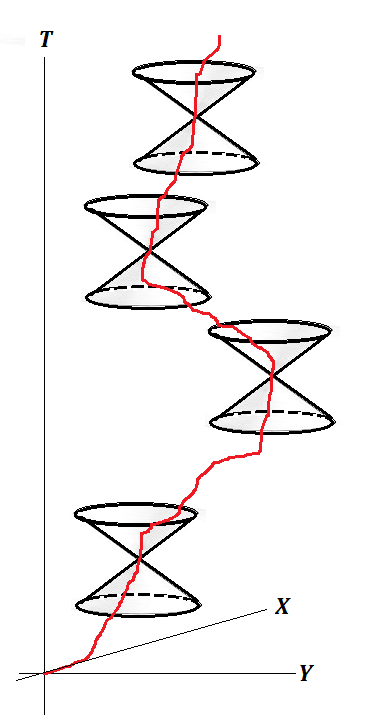Past and Future
in Minkowski Space+Time
We continue analyzing the movements restricted to a two-dimensional XY-plane for visual representation of the three-dimensional Minkowski
Assume, a point at present time t=0 is located at the origin of
As it moves along any trajectory (X(T),Y(T)) on a plane, the world point that represents this movement will be at position (X(T),Y(T),T) in the three-dimensional Minkowski space+time.
The distance from the world point (X,Y,T) to the T-axis equals to
D(T) = √X²(T)+Y²(T)
As we know, the speed of movement cannot exceed a speed of light in vacuum c.
Therefore, during time T the point on the XY-plane cannot deviate in its movement from the origin by a distance greater than c·T and the world point (X,Y,T) cannot deviate from the T-axis by the same distance c·T.
From this follows that for any time T the following inequality is held
d(T) ≤ c·T or
X²(T) + Y²(T) ≤ (c·T)²
The equation
X² + Y² = (c·T)²
represents a conical surface in three-dimensional XYT-space.
Therefore, the inequality
X²(T) + Y²(T) ≤ (c·T)²
represents the inside of this cone.
Below is a graphical representation of this with indication that if our present time is T=0, the inside of an upper cone represents all possible points reachable in the future, while the inside of a lower cone represents all possible points in the past where the moving point could have been located in the past.

If a point in the past (for negative time T) was located outside the lower cone, there is no way it could reach the origin of coordinates at current time T=0, because its speed would have to exceed the speed of light c.
Analogously, any point in the future (for positive time T) outside of an upper cone could not be reached from the origin during the time T, because its speed would have to be greater than the speed of light c.
Therefore, we can state that all world lines that represent all the past and future possible movements of an object located at the origin of coordinates at time T=0 must lie inside the cone described by an equation
X² + Y² = (c·T)²
This cone is called the light cone because its shape (actually, the angle at the top) explicitly depends on the speed of light c.
Of course, any position on a world line can be interpreted as the beginning of a motion with all prior positions along a trajectory considered as the past and all subsequent as the future.
In this case we can require that at any position the world line should be contained within a light cone constructed at it, which can be schematically illustrated by this picture.

Extending the definition of the light cone from three-dimensional Minkowski XYT-frame (that we used for better graphical representation) to a practical four-dimensional Minkowski XYZT-frame (that, unfortunately, we cannot visually represent), we can define a similar light cone as
X² + Y² + Z² = (c·T)²
Now let's express the same thing in term of metrics, assuming the distance between two world points in four-dimensional Minkowski XYZT-frame, presented in the previous lecture Space+Time, is expressed as
D²(A,B) =
= c²·(TB−TA)² − (XB−XA)² −
− (YB−YA)² − (ZB−ZA)²
The condition for two world points to be inside of a light cone (that is, for them to represent the state of some object at two different moments of time, thus belonging to its world line) can now be expressed as the square of a distance between them in Minkowski space+time, as defined in the above formula, to be non-negative, which makes the distance itself to be a positive real number.
If the square of a distance between two points in the Minkowski space+time is negative and, consequently, the distance itself is imaginary complex number, these two points cannot belong to a world line that represents a motion of one point-object, because, to reach one point from another, this object would have to move with a speed faster than a speed of light in vacuum, which is impossible.


No comments:
Post a Comment